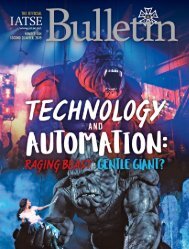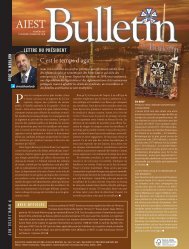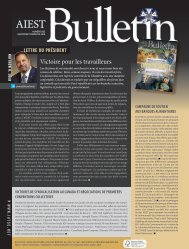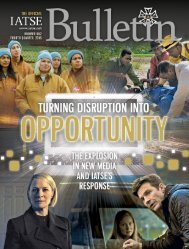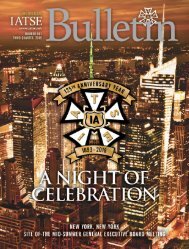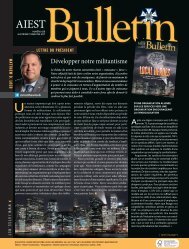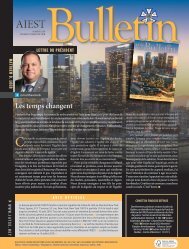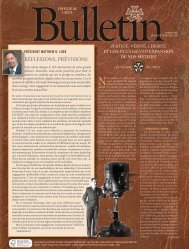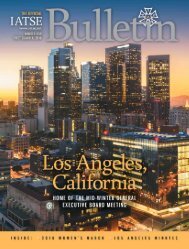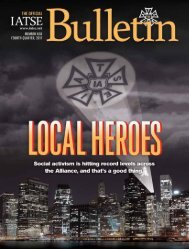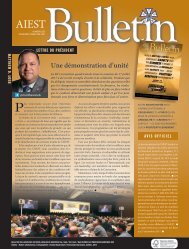IATSE-2nd2018_web
You also want an ePaper? Increase the reach of your titles
YUMPU automatically turns print PDFs into web optimized ePapers that Google loves.
a general strike against producers, demanding recognition of<br />
<strong>IATSE</strong> as the bargaining agent for its members, a closed shop, a<br />
wage increase, overtime pay and double time for Sunday work.<br />
And for the first time, the IA called out the projectionists in a<br />
secondary boycott.<br />
Unfortunately, several studios remained open due to<br />
strikebreakers from the Carpenters. The Department of Labor<br />
eventually settled the strike with a wage scale granted but no<br />
union recognition.<br />
POST-WORLD WAR I HOLLYWOOD<br />
At the end of World War I, the demand for propaganda films,<br />
which had kept the studios busy during the war, dried up. The<br />
influenza pandemic of 1918 killed thousands and kept people<br />
from gathering in crowded places like theaters. Many members<br />
who survived the pandemic lost their jobs, because theaters<br />
closed as a result. The studios briefly closed as well.<br />
Following this bleak period, there emerged a new Hollywood,<br />
dominated not by the lines of work — production, distribution<br />
and projection — but by major motion picture companies.<br />
Fortunately, producers who had been associated with <strong>IATSE</strong> in<br />
the legitimate theaters looked to Local 33 for skilled workers.<br />
Thus by 1919, more than 900 new members joined the ranks<br />
of the IA.<br />
When the <strong>IATSE</strong> contract expired later that year, the Alliance<br />
again went on strike. But this time there was even less success,<br />
as IBEW scabs pledged to fill any jobs left by IA workers as a<br />
secondary boycott. The production companies then began a<br />
campaign of mergers and acquisitions which put the power of<br />
the industry into just a few hands.<br />
The enormous financial output of Hollywood proved a big<br />
attraction for Wall Street. Bankers got involved in the operation<br />
of the studios leading to a sense of insecurity among the workers.<br />
The age of the Movie Mogul had arrived.<br />
THE STAGEHANDS’ CONTINUING STRUGGLE<br />
While <strong>IATSE</strong> members in Hollywood were grappling with anti-union hostility, stagehands across the U.S. and Canada were<br />
struggling with problems of their own. With the rise of the movie industry and the decline of the legitimate theater, many<br />
stagehands resented what they saw as their brothers’ prosperity coming at the expense of their own. They didn’t realize that<br />
their Hollywood brothers were in a battle for their survival — they just knew that their own jobs were disappearing at a frightening rate.<br />
In addition, the advent of the “little theater” — small regional<br />
theaters, sometimes referred to as the “Straw Hat” circuit because<br />
their busy season was during the summer — took attention<br />
away from the well-established, metropolitan theaters. These<br />
little theaters eventually evolved into community theaters, which<br />
concentrated on producing potential hits in the hinterlands for<br />
eventual opening on Broadway.<br />
Compared with 1917, when there were at least fifty of these<br />
small theater groups, nearly 2,000 community theaters were<br />
operating by 1925. These small theaters operated on a shoestring<br />
and did not employ union stagehands. In fact, many depended<br />
on volunteers.<br />
At the same time, a new trend was taking place — a “new<br />
stagecraft” that reflected European trends in set design. It<br />
was more impressionistic and less realistic; more visual and<br />
suggestive, than explicit. Set designers began to use all sorts of<br />
methods to create their desired effects.<br />
On stage, platforms were raised and lowered in a fashion<br />
19




